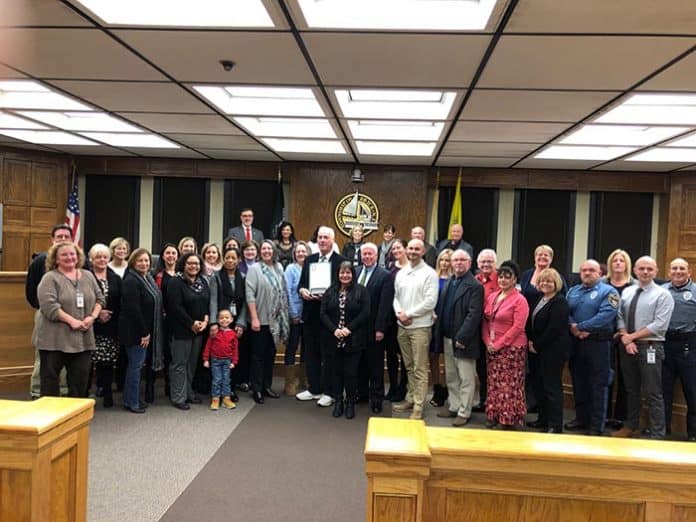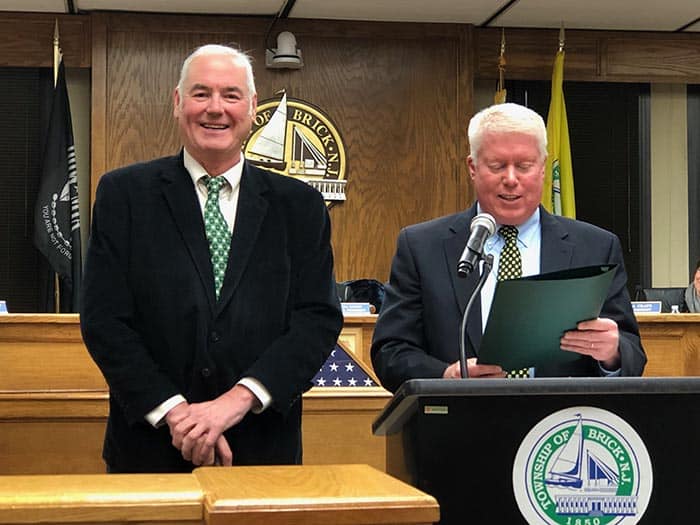
BRICK – In 1980, the population of Brick was about 48,000, and Sean Kinnevy began his career as the township’s zoning officer, the second person to ever hold that position.
In 2019, the population has grown to over 75,000 residents, and as of January 31, Kinnevy, now 63, was retired after nearly 40 years which included a period of time when Brick was the fastest growing municipality in the state.
“My mother always said she moved from the country to the city without leaving her house,” Kinnevy said about his childhood home on Forge Pond Road, where he grew up the oldest of five children.
As the township zoning officer, Kinnevy has been responsible for administering and enforcing the land use ordinances of the municipality, including lot sizes, setbacks, issuing zoning permits for construction, and more.
“There are only two laws that don’t have a statute of limitations in New Jersey: murder and zoning,” Kinnevy quipped during a recent interview at the municipal complex.
In 1980, Kinnevy’s father, John Patrick Kinnevy, was the nonpartisan mayor of Brick who served two terms from 1975-1983 after retiring at age 46 as a NJ State Trooper and was based at the Laurelton Barracks.
“I was 20 when my dad got elected. The town was much smaller and being mayor wasn’t such a big deal,” he said.
Before serving as zoning officer, Kinnevy recalled the summers of 1974-1975 when he installed water meters for the utility company, and the summer of 1977 when he worked at the DPW (Department of Public Works) on a garbage truck.
His family owned a one-car taxi business which Kinnevy and both of his parents drove. His mother worked as a part-time newspaper reporter in Point Pleasant Beach during a time when everybody knew each other.
“It was pretty rural then. The headlines would be ‘Mrs. John Smith’s Sister Visited for a Week from Indiana.’ There was not much news in the 1950s and 60s,” he said.
After graduating from Ryder College, Kinnevy was still driving the family taxi part time until someone put sugar in the taxi’s gas tank during his father’s re-election campaign.
“A deplorable person did that, and that killed the car, so my dad suggested I work at the DPW for a summer as a garbageman. Some people thought I was a spy since I was the mayor’s son,” Kinnevy recalled.
The economy wasn’t good at the time, so Kinnevy had plans to work at the DPW and save money for graduate school, but in June 1980 he injured his knee and got a job in the zoning office since the zoning officer at the time, Alexander George, was on a medical leave due to brain cancer.
“I was hired as an assistant zoning officer – I never really wanted to work for the government, and I certainly didn’t want to work for my father, but I was only one of two people who had a college degree,” he said. “The other person was the township engineer.”
Kinnevy was one of 14 who took the civil service test and scored the highest grade. He took some required courses at Rutgers and became the full time zoning officer in August 1980.
“That’s the last time I was promoted,” Kinnevy joked.
He said after growing up in Brick, and after driving a garbage truck and taxi, he knew the neighborhoods, streets, residents and builders.
The job of zoning officer first became a necessity in cities because someone would open a slaughterhouse next to a school, or someone would build a factory in the middle of a neighborhood, causing parking problems, noise pollution, and other quality of life issues, Kinnevy said.
For thousands of years, the people who lived in this area were farmers, fishermen and hunters, but about 100 years ago, Ocean and Monmouth Counties became a summer destination for commuters who built bungalows and hotels.
There was a big change in the 1950s when the Garden State Parkway opened, opening up the area as an easier commute for people who wanted affordable housing options, Kinnevy said.
At the time, a three-bedroom ranch cost about $6,000, so the population began to increase as towns encouraged growth. Businesses opened, tax ratables increased, and thousands took advantage of the affordable houses. Builders would build a couple of hundred homes at a time, Kinnevy recalled.
“Towns weren’t thinking about crime, traffic, overcrowding and pollution,” he said. “There was nothing here. No water or sewer lines. There were dirt roads, and Brick had no police department or high school. We had general stores with post office boxes, diners and gas stations. We had all the problems of a city but none of the advantages.”
After the Parkway opened, the population became a mix of commuters from northern New Jersey who lived here full time; locals who always lived here; and summer residents, he said.

Over the span of his 40-year career, Kinnevy has seen his department grow to include an assistant zoning officer and a zoning clerk, and the police force grow from ten officers to 140.
People were knocking down or rebuilding houses that were built in the 1950s and moving to Brick full-time. Businesses opened, strip malls were constructed, and Brick went from being a rural summer resort to an “almost urban” area, he said.
“There were still farms here when I started. Brick Hospital was all chicken farms,” he said.
As the township grew, residential and commercial zoning laws became more complicated as “back zoning” became a necessity, meaning zones would be created around what already existed.
“We had the opportunity to create proper planning. For example, if you had a farm or wooded area next to an existing development, you might make the new lots the same size or slightly larger,” he explained.
In the mid-1980s, there was a big building boom. “I was going crazy,” Kinnevy said. “In 1989-1990 there was a big drop in construction, and then again in 2008 there was a big collapse that really affected everything.”
The zoning office had to abide by new environmental regulations that restricted building in the wetlands, and ordinances that would prevent flooding and pollution.
After Superstorm Sandy, the zoning department went from being very slow to the busiest time in its history, Kinnevy said.
“It was horrible, people would come in crying, they didn’t have enough money to rebuild; people wanted to get back into their houses, and we felt for people because it affected us, too, some of our employees also lost houses,” he said.
Kinnevy said he’s leaving at a time when the local government is “very efficient and professional. There is much less controversy than there was in the past, everything is much better.”
Plans for retirement include spending time with his wife, Noreen, daughter, Fiona and his four grandchildren. Kinnevy said he is going to tend to some “deferred” health issues, visit his 95-year old mother who lives with his sister in Massachusetts, and continue to volunteer at his church.
“The job of zoning officer is extremely interesting, zoning covers almost everything,” he said. “It has never been boring, there was always something new every day.”






